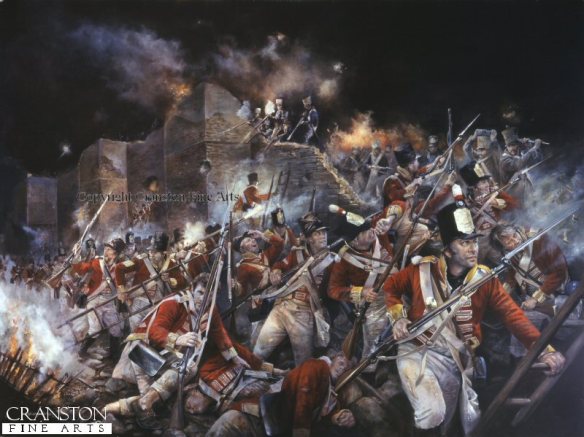Storming of Badajoz by Chris Collingwood.
The last siege of Badajoz conducted by Wellington’s army was typified by a failed main assault on the breech and a successful secondary assault on the castle. The Allies had failed to take Badajoz before, and the lack of an adequate British siege train, along with qualified engineer officers and engineer troops, would make infantry assaults the major instrument in the siege. The gallantry of the British infantry is legendary, and Wellington undoubtedly felt grief over the horrific losses. The skilled defence of Badajoz by General Phillipon and his garrison is contrasted with the amaterish way in which the British engineering arm conducted the siege. The heavy losses prompted the British to create the Royal Corps of Sappers and Miners.
There were four sieges of Badajoz during the Peninsular War, all taking place in 1811-12. The initial siege was undertaken by the French and was a success; it was followed by two failed British attempts. The fourth and last of these operations was also undertaken by the British. This time they carried the day, but it was a very bloody episode and the superb performance of the British infantry was marred by their disgraceful conduct afterwards. They indulged in a three-day orgy of rapine, drunkenness and plunder against an allied and friendly population that had not opposed the British siege operations in any way.
Wellington’s sieges in Portugal and Spain are not noted for the skill and thoroughness with which they were conducted. Many of them were failures, and those that succeeded were usually marked by heavy casualties incurred by the besiegers because the cities had to be taken by storm. Badajoz was one of the keys to Spain; it had to be taken so that the Allied army could continue into the interior and eventually into southern France. It stood on the Guadiana River and water formed a natural obstacle on two sides. The city was strongly fortified and had formidable outworks called the Pardaleras and the Picurina. Across the Guadiana was San Cristobal and the fortified bridgehead for the bridge over the river. The works were garrisoned by about 5000 men ably commanded by General Armand Philippon (1761-1836), who proved a redoubtable adversary.
Siege works were then opened against the eastern side of the fortress on 15 March 1812 amidst terrible weather that made construction difficult at best. The troops that worked on the first siege parallel laboured in water up to their waists and were under heavy French fire from the outset. The French sortied from the fortress on 19 March but were repulsed, and work continued.
Batteries were built to fire on the fortress and on 24 March six batteries opened fire on the Picurina as well as on the San Roque lunette. Additionally, artillery bombarded the main walls, or curtain, of Badajoz between the bastions of Trinidad and San Pedro.
Stolid Defence
Major-General Thomas Picton’s (1758-1815) division assaulted the Picurina on the night of 25 March and took it after a desperate fight; Picton’s casualties were heavy. The next day the British siege guns opened fire on Badajoz once more, this time bombarding the curtain between the Trinidad and Santa Maria bastions. The city wall was formidable however, and it was not until 5 April that two breeches were opened that were believed to be passable by an assault force. Still, Wellington ordered that another breech to be opened before an assault could take place.
Wellington underestimated the lengths to which the defenders had gone to make an assault upon Badajoz if not impossible, then at least as expensive as possible for any attacker. Obstacles had been built in the ditch to render it unusable as a customary rallying place. Although the walls had been breeched, the defenders had erected more obstacles within them and had shored up the defences behind the breeches to stop any penetration of the fortress.
Wellington had planned a main attack by two columns, consisting of the Light Division and the 4th Division, which would go for the breeches. A supporting attack against the fortress’s castle across the Roillas, which was flooded and could only be crossed by a dyke that was 60cm (2ft) under water, was to be made by Picton’s 3rd Division. Other, smaller supporting attacks were to be made on the Pardaleras, the San Vicente bastion and the San Roque lunette.
The attacks jumped off at 8 p.m. on 6 April. The assaults on the breeches were expensive failures, the defenders not only causing the attacking columns horrendous casualties but also taunting the attackers throughout the fighting. The performance and sacrifice of the British officers and men was exemplary, but the defence was too professional and savage, and the breeches were choked with British killed and wounded.
Picton’s attack on the castle at first failed, and Picton himself was wounded. He rallied his men, however, and they gained a foothold on the lower walls. Scaling ladders were raised and the British poured over the parapet. Again, resistance was savage, but the British fought through adversity, taking the castle but with heavy casualties. The San Vicente bastion was also taken, and the heart went out of the defenders.
General Philippon and the garrison withdrew into San Cristobal, where they surrendered the next day. Badajoz thereby fell, and the British troops who had behaved so well in the mayhem of the breeches now went wild and sacked the city. The orgy continued until it finally burned itself out and order was restored. The same would happen when San Sebastian was taken the following year.
